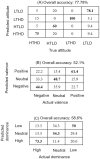Set the tone: Trustworthy and dominant novel voices classification using explicit judgement and machine learning techniques
- PMID: 35767528
- PMCID: PMC9242519
- DOI: 10.1371/journal.pone.0267432
Set the tone: Trustworthy and dominant novel voices classification using explicit judgement and machine learning techniques
Abstract
Prior research has established that valence-trustworthiness and power-dominance are the two main dimensions of voice evaluation at zero-acquaintance. These impressions shape many of our interactions and high-impact decisions, so it is crucial for many domains to understand this dynamic. Yet, the relationship between acoustical properties of novel voices and personality/attitudinal traits attributions remains poorly understood. The fundamental problem of understanding vocal impressions and relative decision-making is linked to the complex nature of the acoustical properties in voices. In order to disentangle this relationship, this study extends the line of research on the acoustical bases of vocal impressions in two ways. First, by attempting to replicate previous finding on the bi-dimensional nature of first impressions: using personality judgements and establishing a correspondence between acoustics and voice-first-impression (VFI) dimensions relative to sex (Study 1). Second (Study 2), by exploring the non-linear relationships between acoustical parameters and VFI by the means of machine learning models. In accordance with literature, a bi-dimensional projection comprising valence-trustworthiness and power-dominance evaluations is found to explain 80% of the VFI. In study 1, brighter (high center of gravity), smoother (low shimmers), and louder (high minimum intensity) voices reflected trustworthiness, while vocal roughness (harmonic to noise-ratio), energy in the high frequencies (Energy3250), pitch (Quantile 1, Quantile 5) and lower range of pitch values reflected dominance. In study 2, above chance classification of vocal profiles was achieved by both Support Vector Machine (77.78%) and Random-Forest (Out-Of-Bag = 36.14) classifiers, generally confirming that machine learning algorithms could predict first impressions from voices. Hence results support a bi-dimensional structure to VFI, emphasize the usefulness of machine learning techniques in understanding vocal impressions, and shed light on the influence of sex on VFI formation.
Conflict of interest statement
The authors have declared that no competing interests exist.
Figures



Similar articles
-
Low Vocal Pitch Preference Drives First Impressions Irrespective of Context in Male Voices but Not in Female Voices.Perception. 2016 Aug;45(8):946-963. doi: 10.1177/0301006616643675. Perception. 2016. PMID: 27081101
-
How do you say 'hello'? Personality impressions from brief novel voices.PLoS One. 2014 Mar 12;9(3):e90779. doi: 10.1371/journal.pone.0090779. eCollection 2014. PLoS One. 2014. PMID: 24622283 Free PMC article.
-
How does familiarity with a voice affect trait judgements?Br J Psychol. 2021 Feb;112(1):282-300. doi: 10.1111/bjop.12454. Epub 2020 May 23. Br J Psychol. 2021. PMID: 32445499
-
How do voice acoustics affect the perceived trustworthiness of a speaker? A systematic review.Front Psychol. 2025 Mar 10;16:1495456. doi: 10.3389/fpsyg.2025.1495456. eCollection 2025. Front Psychol. 2025. PMID: 40129499 Free PMC article.
-
Vocal modulation in human mating and competition.Philos Trans R Soc Lond B Biol Sci. 2021 Dec 20;376(1840):20200388. doi: 10.1098/rstb.2020.0388. Epub 2021 Nov 1. Philos Trans R Soc Lond B Biol Sci. 2021. PMID: 34719246 Free PMC article. Review.
References
-
- Cantril H, Allport GW. The psychology of radio. 1935.
-
- Cuddy AJC, Fiske ST, Glick P. Warmth and Competence as Universal Dimensions of Social Perception: The Stereotype Content Model and the BIAS Map. Adv Exp Soc Psychol. 2008;40: 61–149. doi: 10.1016/S0065-2601(07)00002-0 - DOI
-
- Feinberg DR, DeBruine LM, Jones BC, Little AC. Correlated preferences for men’s facial and vocal masculinity. Evol Hum Behav. 2008;29: 233–241. doi: 10.1016/j.evolhumbehav.2007.12.008 - DOI
MeSH terms
LinkOut - more resources
Full Text Sources

